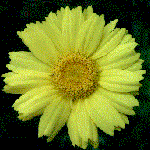 |
ASTERACEAE (formerly COMPOSITAE) - The Daisy Family
This is one of the largest plant families, with over 25,000 species distributed all over the world. It includes shrubs, perennials and annuals, but not trees or aquatics. Many of them are weeds (e.g. Dandelion and Thistle), many are familiar garden flowers (Aster, Chrysanthemum and Echinacea), and some are edible (Lettuce and Artichoke). |
Characteristics of this Plant Family:
Leaves, Stem & Roots ~ The leaves of this family are often undivided and spoon-shaped, but they are sometimes toothed or divided, and they may be prickly. There is often a basal rosette, as in the Daisy or Dandelion, and there may be leaves on the stem, as in the thistle. The stem itself may be solid or hollow and it, too, may be prickly. The roots may be short and near the surface, as in the Daisy, or there may be a long tap root, as in the Dandelion or Thistle.
Flowers ~ It is the flowers which give this plant family its original name of Compositae They are composite, or made up of many individual flowers. These flowers may be regular (disc florets), with all the petals the same size, or irregular (ray florets), with some petals larger than others. Often, the disc florets form the central disc of short flowers, and the irregular ray florets form the outside 'petals' with the larger edge on the outside of the flower head. In the photograph, the dark centre of the flower is the disc florets and the outer 'petals' are the ray florets. Some members of this family are made up of only disc florets or only ray florets.
Recently, the international panel of botanists who rule on these things decided that all plant families ought to have the same ending (-aceae), and be named after a plant typical of the family, so the family is now called Asteraceae after the type plant, the Aster.
Seeds ~ Each single flower can produce a seed. The flowers sit on a disc surrounded by the bracts. After pollination, the seeds grow and mature until they are ripe and ready to be dispersed. In some species, the bracts surrounding the flower simply open and allow the seeds to be dispersed by the wind. In this case, the seed is often attached to its own 'parachute', as in the Dandelion. In other species, the bracts close over the disc while the seeds mature, and this seed case also turns brown as the seeds ripen. When the seeds are ready to be dispersed, they separate from the disc. Seeds of this family are oval and may be flat or rounded. They can be straw-coloured, warm brown or nearly black.
Many members of this plant family do not produce viable seeds. Often, they produce what looks like a fine seedhead of white fluff, but on examination it will be seen that there is no seed at the bottom of the 'parachute'. In some cases, there may be a seed case full of ripe brown 'seeds', but they may be flat or bent and spindly, and if they are compared to a healthy seed, it can be seen that they are not viable seeds. Healthy seeds are easily recognisable - there is a slight bulge to even the flat-looking viable seeds, and some are fat and rounded.
(Click here for more information and examples of seedpods in this Family.)
Members of this Family usually have:
Daisy-type flowers
but are not big trees or aquatic